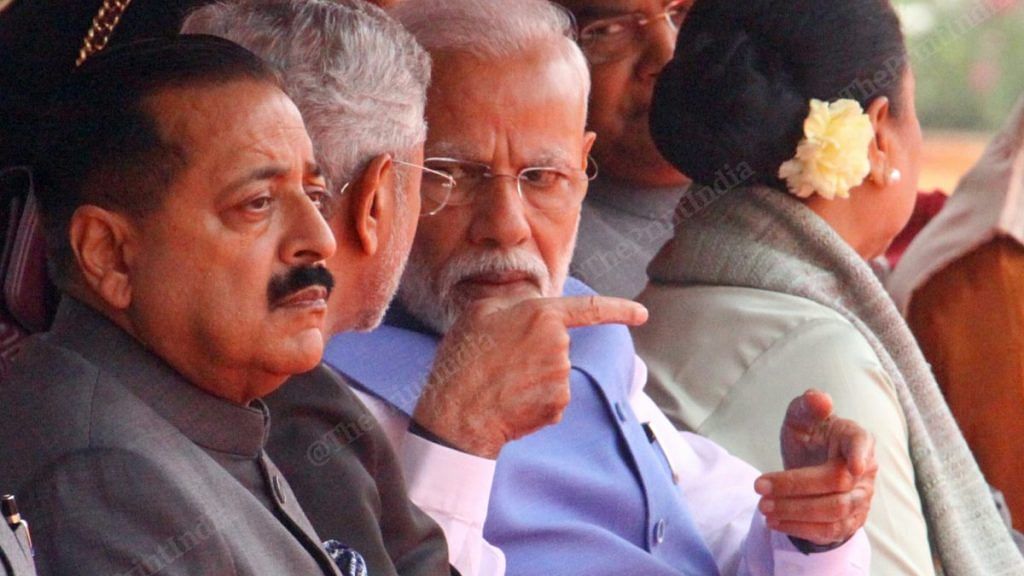Chinese troops have occupied parts of Indian territory in eastern Ladakh, including in the Galwan Valley, a fact confirmed by none other than Army chief Gen. M.M. Naravane, who said last week that both sides are now “disengaging in a phased manner”.
Significantly, it was also left to the Army chief to reiterate, on the same day at the passing out parade of the Indian Military Academy (IMA), that “we have a very strong relationship with Nepal”.
Not that it mattered. Hours later, the Nepali parliament passed a Bill changing the map of its country in which it incorporated a large swathe of Indian territory, from Kalapani to Limpiyadhura. All of Delhi’s protestations about the new map being specious — which it is — were completely ignored by the K.P. Sharma Oli government in Kathmandu.
Also read: Modi-Shah’s Aksai Chin bravado activated China’s Ying Pai to cross LAC
Novel taste of foreign storm
As India’s coronavirus situation becomes worse — we are now ranked fourth globally in terms of Covid positive cases, behind only the US, Brazil, and Russia – Delhi’s neighbours are beginning to fathom the soft underbelly of the giant.
For the first time in decades, a perfect foreign policy storm is gathering to the detriment of India. China is flexing its muscle and poking Delhi in the eye. Nepal’s Prime Minister K.P. Oli is revelling in insulting not just the Narendra Modi government, but India itself, by decrying its sacred national emblem, the Ashoka Chakra. The US special envoy to Afghanistan, Zalmay Khalilzad, has asked Delhi to talk to the Taliban – a request that is anathema to Delhi and goes against the grain of its Afghan policy, because of the Taliban’s close identification with the Pakistani ISI.
As for Pakistan, the Modi government decided early on – since 1 January 2016, when an Army camp was attacked in Pathankot – that it would break off all relations if cross-border terrorism was not stopped. Well, it’s been four years since, and both infiltration and cross-border terrorism continue, killing more and more people in Jammu & Kashmir – which, incidentally, is now ruled directly by Delhi.
Also read: India’s Fingers have come under Chinese boots. Denial won’t help us
A collective failure
How and when did this slide happen? For the last several years, Prime Minister Modi has been the apple of the world’s eye, travelling from continent to continent, enveloping the most powerful men in a bear hug, and greeting female leaders with a respectful Namaste.
Modi’s foreign policy was supposed to be new and refreshing. In his first term, he was supported by some of the smartest men in South Block, including then-foreign secretary and former ambassador to China S. Jaishankar, now his external affairs minister. But nobody saw the Chinese intrusions in eastern Ladakh coming.
Over the past month, in fact, as the Chinese walked a few kilometres across the Line of Actual Control (LAC) into the Galwan Valley, considered to be “settled, and not disputed” by both sides, there has been no word at all from Jaishankar, leave alone Prime Minister Modi.
Nor has the external affairs minister explained why and how India “lost” Nepal, a country with which India has not just political but civilisational linkages. Instead, the first comments on both these matters, besides the government spokesperson, have been from Army chief Gen. Naravane.
Also read: Modi govt’s flip flops widened the gap between India and Nepal. Chinese are filling it fast
Gen. Naravane’s slip
You can almost feel bad for Gen. Naravane. He made some totally insensitive remarks about Nepal, hinting that Kathmandu was being instigated by China. The kindest explanation is that the Army chief is a straight-shooting kind of person – as men of his ilk often are – and didn’t realise that he was causing a diplomatic incident.
But if you really think about it, shorn of diplomacy, Gen. Naravane was not speaking an untruth. The fact is that Nepal’s K.P. Oli was almost going to lose his job as prime minister when the Chinese threw him a lifeline, with the caveat that he had to spit on India’s face – and he took it.
From his comments at the IMA parade, it seems as if Gen. Naravane was being persuaded to make amends for his indiscretion. He gave the facts again, that disengagement in Ladakh is taking place and that Nepal and India have the oldest and closest relationship in the world. Were they the full facts? Certainly not.
But the question remains: Why was an Army chief making comments that really should be the remit of the Foreign Office?
This has been a bad month for India. The Chinese have taken the heights at Galwan and are camping a few kilometres inside Indian territory. On the face of it, that sounds like what happened in Kargil in 1999, when the Pakistani army took the heights. After all, the LAC, like the LoC that separates India from Pakistan, is not a settled boundary.
The best case scenario is that the Chinese will withdraw and return to status quo ante, like they did when they intruded in Chumar in 2015, during Xi Jinping’s visit to India. The worst case scenario is that they will sit tight where they are today — an untenable solution. A middle course of action is what happened in Doklam in 2017 — the Chinese withdrew, but not to their positions before the intrusion; moreover, they built structures, put you on eyeball-to-eyeball notice.
That’s the message in Ladakh: Mess around with China, and this is what you get.
Meanwhile, here at home, the Covid crisis grows and grows.
Views are personal.
